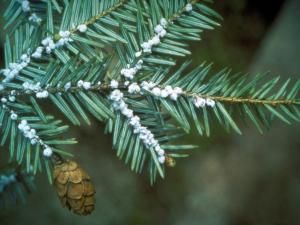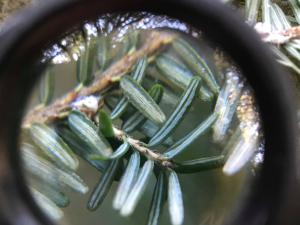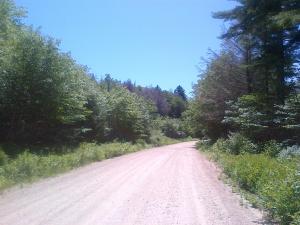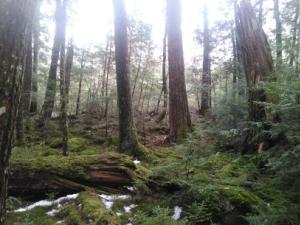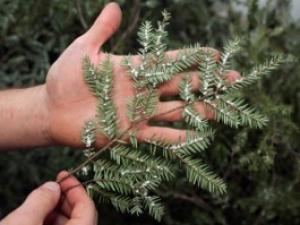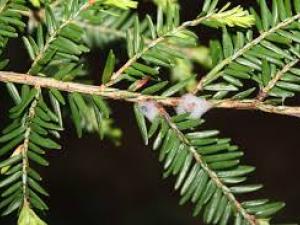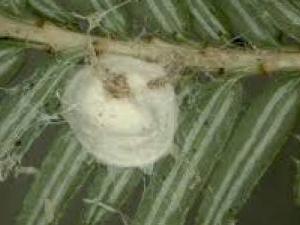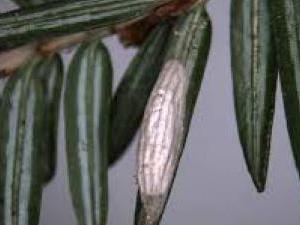When and How to Detect HWA
HWA is easiest to identify by the presence of small woolly masses on the underside of hemlock twigs near the base of the needles, which can be seen in late fall, winter, and early spring. HWA goes through four development stages or “instars” as it secretes its “wool” then lays its eggs as an adult. During this time, an infestation will be characterized by white, waxy masses that are secreted around the bodies of the insect, always clumped on twigs near the base of the hemlock needles. Tips: Sometimes the infestation is best seen while looking at the underside of a hemlock twig. In the case of a lighter infestation you may only see one or two woolly masses present. The photo to the right shows a heavy infestation.
In late spring to early fall, HWA is not growing; they are in a dormancy period known as aestivation. This time of year, HWA appears as small black nymphs, called sistens, at the base of hemlock needles on tree’s new growth. The sesame seed-shaped sistens will have a distinct white halo. Finding HWA at this time of year may require use of a magnifying glass or hand lens (7x or 10x magnification). Tips: It may help to look at underside of twigs for HWA; remnants of wool from previous season may also be present.
Look for remnant egg sacs on the tree trunks, especially when wet. If there are no reachable branches, Hemlock Woolly Adelgid may not be detected without the use of other detection tools. Checking tree trunks for remnant egg sacs may be one of the only ways to confirm the presence of HWA.
Look for fallen branches from the trees canopy on the forest floor, especially after a wind storm. HWA can go undetected in the lower branches but fallen brances can reveal HWA from above. In some older hemlock stands it is difficult to reach the upper branches, so taking advantage of the windfalls is important.
Many things look like hemlock woolly adelgid at first glance. On closer inspection, they can be ruled out by either their texture, their location or another characteristic. Remember, HWA will usually be found on the undersides of twigs at the bases of needles and is coated with a waxy material.
Don't be fooled by common imposters on hemlock, such as this spittle bug! Spittle bugs are another sucking insect that can be found on hemlock branches, but they produce a frothy blob that resembles spit, rather than a woolly mass, which surrounds the nymph. Spittlebug foam is not found in winter or early spring when HWA is detectible.
At first glance spider eggs sacs can also look somewhat like HWA and require a second closer look. They vary by species, often forming large to medium balls of webbing, which may be attached to multiple needles and twigs. Spider egg sacs are more fibrous than HWA ovisacs and can be easily pulled apart. They are not harmful to the trees.
The oak skeletonizer is a small moth that lays its eggs on oaks where the larvae feed until they move off the host to pupate. The pupae spend the winter in small, white cocoons which may be attached to fallen leaves, branches and limbs of any trees, including hemlocks. They resemble ribbed grains of rice, distinguishing them from HWA.
Slingshot sampling is another method used to sample for hemlock woolly adelgid in high branches. A slingshot is used to shoot a velcro covered ball into the upper canopy of hemlock trees, where it will collect HWA samples if present.
Another detection tool is the pole pruners that can reach into the upper branches to detect a light infestation that could be missed otherwise.
If you find HWA, please report your sighting.

